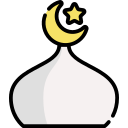
- Share to:
Life Of The Buddha
“Life of the Buddha” (Buddhacarita) was composed by a Buddhist monk named Ashva·ghosha in the first or second century CE probably in the north-central Indian city of Ayódhya. This text is the earliest surviving example of the Sanskrit literary genre called kāvya (ornate epic poetry) and probably provided models for Kali·dasa’s more famous poetical works. The fourteen Cantos extant in Sanskrit take the reader from the birth of Siddhártha, the future Buddha, to his Awakening when he discovered the truths of the Buddhist doctrine. Some of the most poignant scenes of the text take place when the young prince is, on the one hand, confronted by the reality of human life subject to sickness, old age, and death, and, on the other, seduced by the charms of the women employed by his father to keep him at home.
Although it is a poetic composition of the highest order, Ashva·ghosha’s main aim is not to entertain but to instruct, to present the Buddha's teaching as the culmination of the Brahmanical tradition. His wonderful descriptions of the lovely bodies of the courtesans are ultimately meant to show the transience of beauty:
Others, grasping branches
of mango in full bloom,
bent down to expose breasts
resembling golden pots. (4.35)
In sleep these same lovely girls reveal their true nature, which prompts Siddhártha to leave home and become an ascetic:
Another was lying as if she was drunk,
mouth wide open and saliva oozing,
legs wide open and genitals exposed,
body distorted, looking repulsive. (5.61)
สถานภาพ
| 0000800 | BQ 1606 .B8322 E54 2007 | Research Library (อาคาร 1 ชั้น 4) | พร้อมให้บริการ |
Detail Information
- ชื่อชุด
-
Clay Sanskrit library, 33.
- เลขหมู่
-
BQ 1606 .B8322 E54 2007
- ผู้จัดทำ
- New York University Press & Fo : New York : New York University Press : JJC Foundation, 2008.., 2008
- ลักษณะวัสดุ
-
LV, [1], 497, [1] s. ; 17 cm.
- ภาษา
-
English
- ISBN/ISSN
-
9780814762165
- หมวดหมู่
-
Buddhism
- Content Type
-
-
- Media Type
-
-
- Carrier Type
-
-
- ครั้งที่จัดทำ
-
1
- หัวเรื่อง
- ชื่อเรื่องเพิ่ม
-
-
- Statement of Responsibility
-
-
 Computer science, information & general works
Computer science, information & general works
 Philosophy & psychology
Philosophy & psychology
 Religion
Religion
 Social sciences
Social sciences
 Language
Language
 Pure Science
Pure Science
 Applied sciences
Applied sciences
 Arts & recreation
Arts & recreation
 Literature
Literature
 History & geography
History & geography